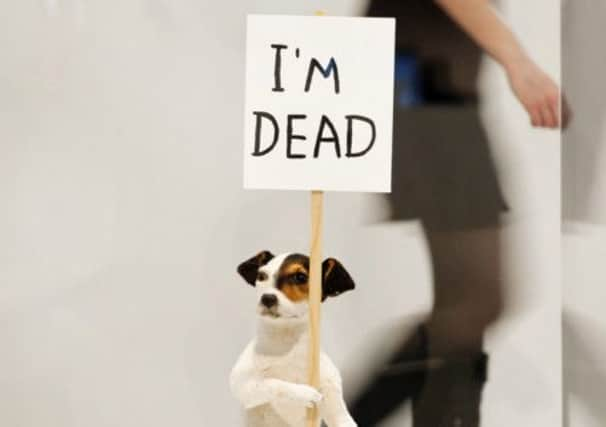Turner Prize finally taking David Shrigley seriously


Whatever the outcome in Derry/Londonderry in December, his name will now always be prefaced with those awkwardly conjoined words Turner Prize-nominated.
There was a certain odd frisson in the news that the Glasgow artist had been nominated for this year’s prize alongside Tino Sehgal, Laure Prouvost and Lynette Yiadom-Boakye. His 2012 mid-career retrospective Brain Activity, at London’s Hayward Gallery, had been a popular and critical success. But had it really taken this long? Surely he had been nominated years ago?
Advertisement
Hide AdOf his peer group – he is 44 and graduated from Glasgow School of Art in 1991 – he is the best known outside the conventional confines of the art world. As a cartoonist in press and print, creator of record sleeves, videos for the likes of Blur, and occasional songwriter he has reached the widest of popular audiences.
You’ll find his work in ordinary bookshops as well as gallery outlets. After a project to design tattoos for the Frieze art fair, you’ll even find it inscribed on the skin of diehard fans. Recently he was in Aspen, Colorado, where they had invited him to create a ticket for the ski lift. In 2012, his libretto for Pass The Spoon, his “sort-of opera” with Magnetic North, showed he could even do musical theatre. And do it very well.
There have been suggestions in the press this week that Shrigley had been overlooked in the past because he was funny. And by implication that it took a major show like his retrospective to remind us that he did more than draw and he was also very smart.
Shrigley himself tends to portray his art as workaday, and his daily routine as dull. But one shouldn’t underestimate either his underlying gravitas or his steady determination. The opposite of seriousness, he said in a recent interview with the cult American novelist Dave Eggers, is not humour: it’s incompetence.
His drawings, sculptures and animations have such a strong character, that the adjective Shrigleyesque is widely understood. A quick tour round Brain Activity clarified exactly what such an adjective meant: there was the strangely coiled intestinal creation entitled A Strange Toy For Strange Child. Plus the weird lump of plasticine that close up was a vortex of little creatures entitled The Contents Of The Gap Between The Refrigerator And The Cooker. There were taxidermied creatures, from squirrels to ostriches, which had lost their heads. And the pert little Jack Russell first seen at Kelvingrove Museum waving a sign that read “I’m Dead”.
Above all, there were his trademark drawings: the shaky lines, misspellings, grossly misshapen bodies, signalling as loudly and economically as possible the tics of anxiety, dark imaginings and bodily humour that trouble us all.
Advertisement
Hide AdHis trademark bad handwriting, his truly awful drawing, is careful and hard won and, like much of Shrigley’s work, occupies a strange line between comfortingly familiar and weirdly frightening.
The artist Jonathan Monk, Shrigley’s former flatmate, once suggested that all of us had a David Shrigley font on our computer. Look down at your own writing sometimes and you sense there is a bit of a Shrigley’s unhinged hand at work. Like his little sculpture of a philosopher’s head made from a smooth ceramic vase holding a cactus, he recognises that inside all of us is something pricklier, odder and more embarrassing than simple grey matter.
Advertisement
Hide AdShrigley comes from a religious family and there’s a sense that that biblical background has served him well. His art is full of good and bad choices, moral outcomes and Old Testament cataclysmic events. The morals are pretty straightforward: don’t kill people and do remember to brush your teeth.
Recently a writer for the New Yorker asked him whether “living in bleak, industrial Glasgow might have something to do with the glum existentialism that imbues his art”. Shrigley lives with his wife Kim and their dog in a leafy part of the West End. His art has often featured the expanses of Kelvingrove Park, although it probably focuses more on the scabby pigeons and squirrels than the finest flora. These days, like many middle-aged men, he does yoga and goes for runs. One can only picture the scrupulously polite smile, for he is unfailingly polite in interviews, when he replied: “I go to nice restaurants. I go to see experimental music and book readings. I don’t hang around with the tough guys.”
And yet, looking at his earliest art you can see the impact that a city that was undergoing convulsive changes when he arrived from suburban Leicester in 1988 may have had on him. One of my favourite of his photographs is the little painted box in a wasteland emblazoned with the words “Leisure Centre”.
In a recent BBC documentary about the art of his home city, Shrigley pondered the fact that while some European cities had been destroyed by bombing, Glasgow had somehow been flattened by planners. When Shrigley says this kind of thing it’s in a kind of awed wonder at our capacity for self-inflicted wounds, but also our needless deference to authority. It’s like the tiny placard he once placed in front of the showpiece Armadillo on the Clyde saying “Ignore this Building”.
Shrigley’s is an art of empathy and quiet revolt. “I don’t want to permanently alter the world…” he deadpanned in the blurb for his Hayward exhibition. “Only the city council is allowed to change things forever.” «
Twitter: @moirajeffrey
• The Turner prize winner will be announced on 2 December